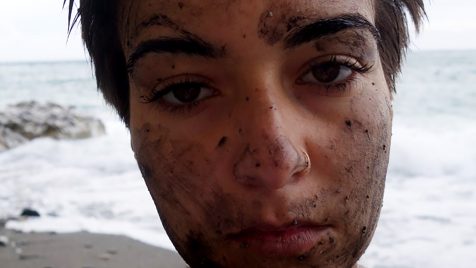
Marta Troya
The CSULB College of the Arts, and School of Art, welcome visiting artist Marta Troya to Art110 this week. On Tuesday Marta gave an inspiring talk about her art practice, and on Thursday she will be leading students in Turning Pages, a work exploring the evolution of spaces like the CSULB University Library and the CSULB Bookstore.

Art & Life
Art comes from life, not from the studio
— Marina Abramovic
What excites me most about Marta Troya’s work is her constant drive to explore new things and places, to interact with people, and to explore being alive.
Growing up in Málaga, Spain “art” equalled painting. So Troya expanded her horizons by studying art at Kingston University in London. When she realized that the fun she was having with her friends and roommates wasn’t advancing her art practice she rented space in a houseboat on the River Thames.
For many people the diversity and richness of London might be overwhelming. But Troya kept pushing to expand. She spent a semester studying sculpture at the Central Academy of Fine Arts in Beijing. She didn’t let the fact that she didn’t speak Chinese stop her. When the language barrier made benefitting from her classes difficult, she left the classroom and took to the street to experience the people, culture, creativity, and art there. That investigation turned into a solo show at Aotu Studio in Beijing.
Then a residency at Tasara Weaving Centre in Calicut, India. Again, not speaking the language didn’t stop her. She found break time and sharing food to be the time she was best able to communicate with others at the Weaving Centre. From that residency she not only produced weavings, but also launched a consideration of food and its human connections that she may continue next week in her residency at Andrea Zittel’s Wagon Station Encampment in Joshua Tree.



Yellow
Activating the five sense through an investigation into the colour yellow and its references.
In-Organic
Marta Troya first moved to Beijing in 2014 and was breath-taken by China’s millions of indefinable accumulated objects. Through photography she developed an interest in the artisanal. In her photos she realised there was a great reference to cleaning artefacts, being most attracted at their aesthetic appearance as they looked like sculptures by themselves. She therefore developed a series of sculptures exploring basic, traditional materials found in everyday Beijing. Starting from dismantling a broom, her work leads to unexpected outcomes as she develops and changes the purpose of the object.

Umbrella Revolution

When Troya found herself in Hong Kong during the Umbrella Revolution she created a portfolio of photographs of the street art of the revolution. When she returned home to Beijing she was shocked to discover the media blackout and distortion of the events in Hong Kong. She shared her Umbrella Revolution collection with her fellow art students at the Central Academy of Fine Arts. They were shocked by what they saw and inspired by the idea that as artists there is always more to see. There are always other points of view to look from.
RCA
The day before speaking to our class Troya received an acceptance email from the Royal College of Art, London (RCA). She’s been accepted into the graduate program there.
Just going from undergraduate to graduate student would be too easy for Troya of course. She’s decided to take the coming year as a gap year before grad school. She’s already planned another trip to India to teach art this summer. I’m excited to see the places and experiences to come in Troya’s unfolding career.
Marta Troya will be turning 21 this Friday.


Comments? Questions? What great art did you see, make, or experience today?